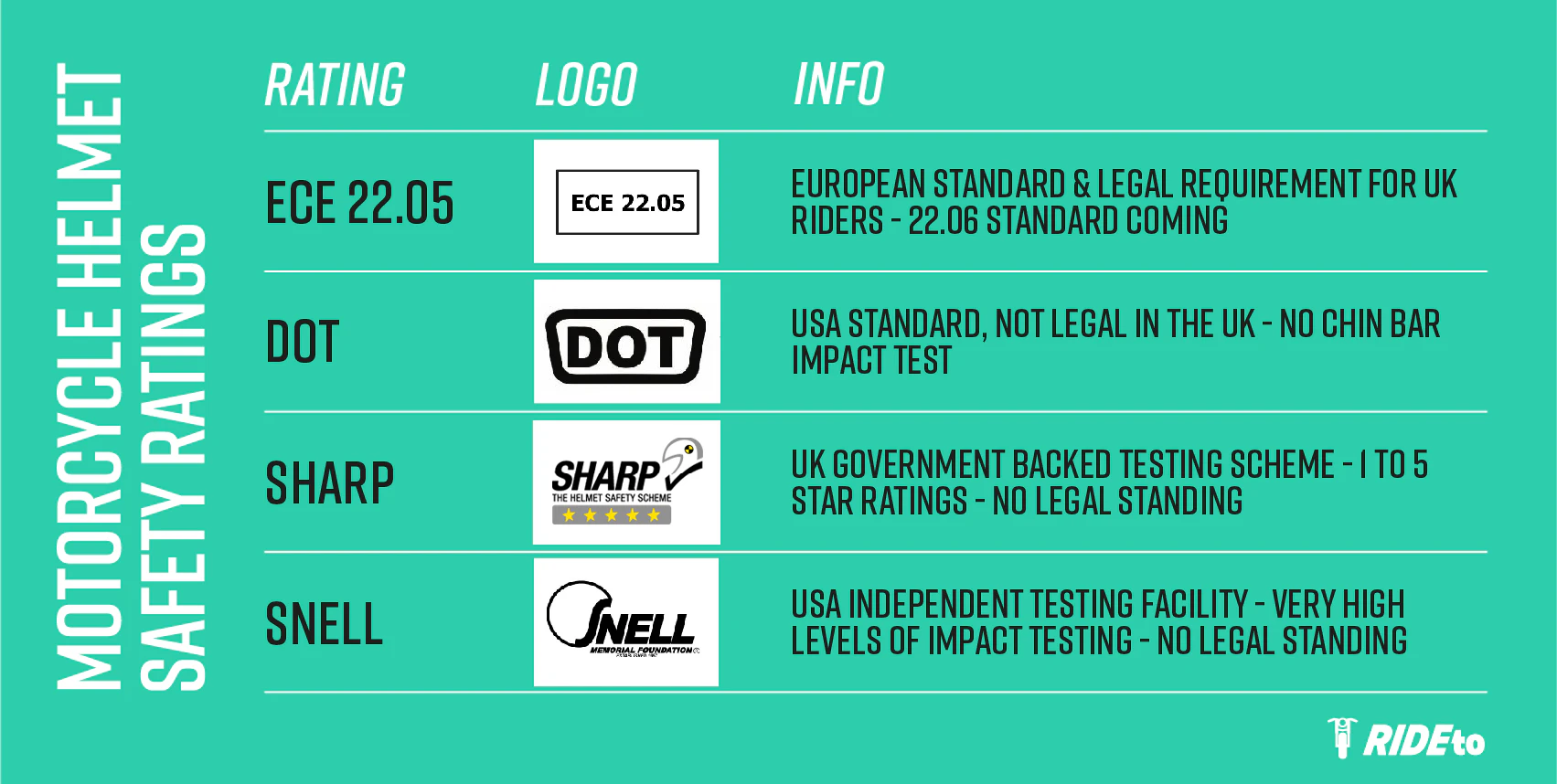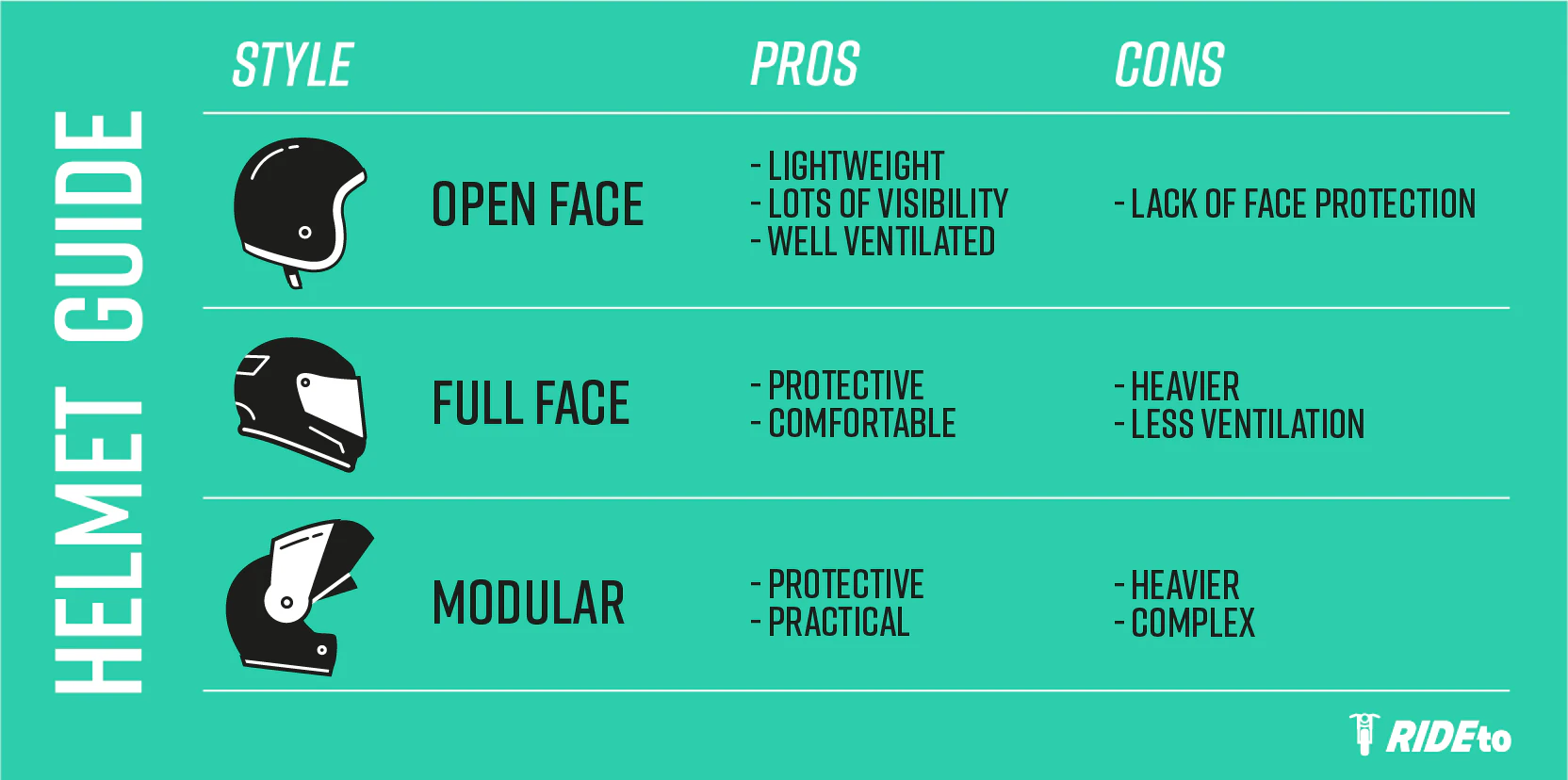back to the blog
Buying A Motorcycle Helmet - A Beginners Guide

James B · April 25, 2024
A motorcycle helmet is undoubtedly the most important piece of protective clothing you will ever wear when riding your motorcycle. Therefore, you must know as much as possible before spending your hard-earned cash on your first helmet.
This guide covers the different styles of motorcycle helmets available in the UK and how to buy a motorcycle helmet online that fits properly.
We will also demystify some of the jargon you’ll be bombarded with during the process. To find the best motorbike helmet to suit your budget and your needs, take a look at our selection in the RideTo Store where we’ve picked the best beginners motorcycle helmets.

There are several safety ratings applied to motorcycle helmets, but the one that is essential when riding in the UK is the ECE standard. Any helmet that has not been tested to the ECE 22.05 standard is not legal for use on public UK roads.
The ECE 22.05 relates to a series of tests that the helmet must pass to achieve certification. Any helmet bearing this code is not only legal, but it also means it meets the minimum safety requirements. Many manufacturers construct their helmets to far exceed this standard. These are predominantly more expensive due to the high specification materials in the construction. More on this later...
There is a new ECE22.06 standard arriving with far more stringent tests, but an existing 22.05 helmet will still be legal.
Another motorcycle helmet safety rating you may come across is DOT, which is an American classification. Legally, you cannot ride on the road with a DOT helmet in the UK, although that doesn’t stop some retailers from selling them.
Some organisations offer independent testing. Snell is one such organisation and is widely respected, and SHARP is another main one. SHARP is a government-funded scheme that runs independent testing, and publishes the results online, rating each helmet based on set criteria.
What Style of Motorcycle Helmet Should I Choose?
This is, of course, an entirely personal choice, but there are considerations to be made. Initially, helmets can be broken down into two distinct styles: Open Face helmets and Full Face motorcycle helmets.
Open Face Helmets
Open Face helmets were the original motorcycle protective helmets produced and have remained popular with classic and custom bike riders. They are great for getting that wind in the face feeling, and all-round vision is second to none. However, in the event of a crash, they offer no protection for your face. You also won’t believe how much a bee hurts hitting you in the face at 60mph! Let alone a stone, so eye protection is essential when wearing an open face helmet.
Full Face Helmets
Full face helmets offer protection to your entire head, but some people may find them a little claustrophobic. Some styles provide wider openings, usually ‘Adventure’ or ‘motocross’ helmets.
Motocross helmets don’t have a visor and are designed to be worn with goggles. These offer that ‘wind in the face’ feeling of an open helmet but with the added facial protection in a crash. The downside is they tend to be noisier. A full face helmet with a visor is the best all-round, all-weather, safest solution for most riders.
There is a halfway house between these two styles, and that's the ‘Flip up’ or ‘Modular’ motorcycle helmet. This is essentially a full face helmet, but the chin guard and visor are hinged to enable them to be ‘flipped up’.
Flip Up Helmets
Flip up motorcycle helmets are popular helmets for touring and commuting as you have all the benefits of a full face helmet, with the ability to transform into an open face mode.
Flip-up helmets make it handy when refuelling, talking to people or cooling down in slow or stationary traffic.
Most modular helmets are certified for use on the road in both closed and open positions, but make sure you check before you buy. Flip front helmets are also popular with riders who wear glasses. It usually means they don’t need to remove them when putting on their helmet.

To save new riders time and money shopping around, we've shortlisted and reviewed 3 of the top-selling helmets in each style on the RideTo Store. Read on to find the best helmet for you.
Best Open Face Motorcycle Helmets
Entry Level Helmet
LS2 Verso - An open face helmet with a full-length face shield/visor. A popular style of helmet with scooter and urban riders.
It offers a wide field of view with decent weather protection from the full visor. This helmet is made from a composite plastic mix, making it relatively lightweight.
The LS2 Verso has a drop-down sun visor, a quick and easy micrometric chin strap, and also offers excellent ventilation via a port in the top of the helmet.
If you are on a tight budget and have a long oval head shape, this is an excellent choice at only £119.99.
Mid Level Helmet
Shark City Cruiser - This Shark helmet takes the open face/full visor concept and pushes on a little further.
The sides of the helmet reach forward to offer more protection, so it's closer to being full face.
Made of thermoplastic, it provides a good balance between weight and price. It also offers a drop-down visor, micrometric buckle and extra ventilation.
If you like the style and have a round/oval head shape, the Shark City Cruiser offers a plush finish for its £169.99 price.
High Level Helmet
Arai Freeway Classic - The Freeway Classic is a premium open face helmet from the Japanese manufacturer who has been developing motorcycle helmets since the 1930s. Arai remains one of the most highly respected motorbike helmet manufacturers in the world.
All Arai helmets are hand-made to the highest standards in one of the four factories in Japan.
Their helmets are one of the best, which can be seen in the premium finish and use of only the best materials.
This composite helmet with an intermediate oval head shape is light, strong and features a fully removable and washable lining.
It’s fitted with high-quality leather trim, a double D-ring chin strap and a triple-density eps liner. One of the best open face helmets you can buy at £349.
Best Full Face Motorcycle Helmets
Entry Level Helmet
LS2 Rapid- A great entry-level motorcycle helmet for riders on a tight budget.
Made from an ABS plastic shell with a long oval fit profile, the Rapid is a basic full face helmet.
It has a quick-release visor fitted with an anti-fog shield and again features a micrometric chin strap. Vents on the chin bar and top of the helmet provide decent ventilation, and there's no denying the value at £49.99. It might not last as long or be as comfortable as a more expensive helmet. Still, it offers adequate protection at a very low price.
Mid Level Helmet
Mid Level - AGV K3 - This thermoplastic shelled offering from Italian Manufacturer AGV offers many features for a mid-level helmet.
It’s racier look is backed up with a four density EPS liner, and it’s suited to a round oval head shape.
As you spend more money on a helmet, you start to notice the improvements quickly. This is evident from the K3’s features list, including five air vents, removable washable liner and drop-down sun visor.
If you’re looking for a more aggressively styled helmet with good safety and features the AGV K3 at £189.99 is a great choice.
High Level Helmet
High Level - Arai Profile V - Arai has a philosophy of building the most robust helmets possible that far exceed the required standard for a CE rating.
This means that they often exceed the requirements quite significantly. The Profile V is considered a mid-level helmet for Arai, but we class it as a high-level product compared to many brands.
It has the same composite shell as their race helmets and is suited to an intermediate oval head shape.
The shell has the signature Arai shape which is designed to be as safe as possible in a crash. It's a well-featured helmet which is light, incredibly strong, comfortable and quiet. You will be hard-pressed to find a better helmet at its price of £379.99
Best Flip Up Motorcycle Helmets
Entry Level Helmet
LS2 Strobe - Again an LS2 helmet features as our entry-level helmet because we feel at their price levels it's a brand that's hard to beat on quality.
The Strobe has an ABS plastic shell which offers the right mix of weight, strength and price.
As with all LS2 helmets, it suits a long oval head shape and has the features you’d expect.
A drop-down visor, removable liner and micrometric chin strap all come as standard and at a price of just £80 it's a good entry flip up helmet.
Mid Level Helmet
HJC i90 - The i90 is better suited to riders with a round head shape. It has a relatively low profile, and a compact shell, popular with touring riders and commuters alike.
Made from Polycarbonate the helmet offers a good balance between weight and price and is well featured too.
The liner is made from a material to help keep the rider cool and has grooves that accommodate glasses, so if you don’t have 20/20 vision is a great choice.
There is plenty of ventilation, and the drop-down sun visor has an anti-fog and anti-scratch coating. At £179.99 it’s a well priced mid-range modular helmet.
High Level Helmet
Simpson Darksome - Simpson return to their 70's design with their Darksome flip up. Thanks to its materials, this helmet is very lightweight, weighing just 1,510g. The shell has an aerodynamic design and is made of Ultralight Tricomposite (a mixture of carbon fibre, Dupont™ Kevlar® and fibreglass). It will suit riders with head shapes between medium oval and neutral, meaning it would suit most riders heads. At £399.99 this sits on the upper price range, with more premium features.
Are All Motorcycle Helmets Constructed the Same?
When it comes to helmet construction, not all helmets are equal. The outer shell material has a significant influence on how they perform for safety and makes a difference to noise when riding. Most high-end helmets concentrate on making a very-hard shell, which allows the internal construction to do its job of protecting your head effectively. All helmets follow the same basic principle of a hard outer shell, inside which lies a soft layer to absorb impact shock, with a final liner for rider comfort.
The middle layer is almost always an ‘EPS’ or Expanded PolyStyrene. Its job is to slow down the movement of your brain moving inside the skull during an impact. Cheap motorcycle helmets tend to have a single layer of EPS of the same density. Whilst more expensive helmets have multi-layer EPS sections where they can vary the amount of softness in the material depending on where it is in the helmet.
We would recommend looking for a Multi-density EPS clarification on your helmet. The stronger the outer shell, the better the EPS performance needs to be. Having a hard shell surface is vital in ensuring that the helmet is not compromised or punctured by sharp objects. Carbon Fibre helmets are extremely strong and lightweight but tend to amplify external sound, making them generally noisier. Generally, a mix of materials or ‘Composite’ is used such as Carbon Fibre, Fibreglass and other aramids. Due to the strength of these materials, the shells can be thinner and therefore lighter.
Another widely used helmet material is plastic, either a ‘thermoplastic’ or a ‘thermoset resin’. These materials make shell production much cheaper, but the material is less rigid. To meet the ECE testing requirements, thermoplastic and resin shells are thicker, which causes them to be heavier. The obvious benefit to this material is the lower production cost, so it's a material generally found in the lower price ranges.
How Should a Motorbike Helmet Fit?
Lastly and most importantly is the fit. A properly fitted helmet is essential not only for comfort but also for safety. A poorly fitting motorcycle helmet will not provide all the protection the manufacturer intended, so make sure you spend plenty of time getting the fit right.
The first step in the process is to establish your size. You can find your head measurement by measuring around your head just above your eyebrows and keeping the tape on the widest part of the back of your head.
You can then compare this measurement to various manufacturers' size charts. However, this is only an initial indication as brands will use different headforms to cater for different head shapes.
There are essentially three primary head shapes:
- Round Oval
- Intermediate Oval
- Long Oval
Motorcycle helmet brands tend to stick to a particular shape. Still, some will offer different helmets forms by helmet model, confusing we know!
There is some variance in head shape, but as the human head is naturally oval-shaped, you will see both round and round oval used as a descriptor. We put together this handy overview of typical helmet shapes by motorcycle helmet brand based on our own experiences and research.
How Do You Know What Shape Your Head Is?
Once you’ve determined your head’s circumference to check the size, you can measure from front to back and side to side to get a (rough) idea of the shape of your head.
Checking The Fit
It’s relatively easy to establish your head shape at home using this guide. A correctly fitted motorcycle helmet should:
- The helmet should fit with the top of the viewport or visor area sitting just above your eyebrows.
- You should feel even pressure throughout the helmet. If there are any ‘hotspots’ or specific areas where you feel pain or pressure, it's not the correct fit.
- If the helmet feels good, grab the chin bar (or outer shell if it's an open face). Holding the helmet in a static position, try to rotate your head from side to side, then up and down (ensuring the chinstrap is fastened).
- The helmet should hold in place, moving your skin a little. If you can turn your head within the helmet, then it's too big.
A helmets inner linings compresses over time, so it does need to be quite snug when new, but never tight to the point of being uncomfortable.
Many top-end motorbike helmets offer linings and cheek pads in various thicknesses, ideal for fine-tuning the fit.
For example, a helmet may be a perfect fit on your head, but the cheek pads are too tight and give you that hamster look. A quick switch to a thinner set of cheek pads will make all the difference. (some even come with thin removable layers within the cheek pads to alter the ones you have)
So although it may initially sound like quite a task to buy a motorcycle helmet, if you remember the key elements, it's quite simple:
- Take an accurate measurement.
- Determine your head shape.
- Get the fit spot on.
- Pick the style that suits.
We would recommend spending as much money as you can afford on your motorcycle helmet. You only have one head after all.
Oh and one last word of warning, don’t be tempted to buy a ‘bargain’ or a cheap helmet from a random online seller and never buy a helmet second hand - you don’t know how many times it’s been dropped!
Always buy your motorcycle helmet from a reputable retailer such as RideTo. All of our helmets are the world's leading brands, supplied directly to us through official UK distributors. Our most popular brands include; Arai, HJC, LS2, Shark, AGV and many more!
Buying a Motorcycle Helmet FAQs
Below are the top questions new riders ask us about buying their first motorcycle helmet.
Q. How often do I need to change my motorcycle helmet?
A. Manufacturers recommend replacing a helmet every 7 years (from the date of production). This is because the EPS liner breaks down over time, thus reducing the helmet's protection. Sweat and oils will break it down faster, so if you wear your helmet daily, we recommend changing every 3 years or earlier.
Q. How do I clean my helmet and visor?
A. Generally, good old fashioned warm water is enough to clean your helmet. Still, there are many products on the market specifically designed for the purpose. The Muc-Off Helmet Care Kit has everything you need to keep the inside and outside of your lid looking sparkly and smelling fresh.
Q. Is it legal to have a coloured or tinted visor?
A. From a legal perspective, tinted visors are acceptable for daytime use as long they allow 50% light transmission. However, it's very much a grey area as there is no hard and fast legislation. Each UK regional Police Force seems to have slightly different views. Generally, Suppose you feel like the visor tint negatively impacts your day vision. In that case, we recommend against it or go for a lighter shade.
Tinted or coloured visors should not be worn at night or in poor weather conditions. If you only have one helmet or it’s your first helmet, we would strongly suggest going for a clear visor.
Q. What shall I do if I drop my helmet?
A. If you drop your helmet from more than a few inches, we strongly recommend that you replace the helmet. The EPS liner is designed to deform in a crash to protect your head, so an impact of reasonable force can alter its state leaving a risk that the helmet will not protect you as intended in a crash. ‘If in doubt’ swap it out’.
Q. If I buy a helmet online and it doesn't fit, can I return it?
A. Yes, if you buy a helmet from the RideTo Store it can be returned if it is unused and in the original packaging. It must arrive back to us in the same condition that it was sent.
Q. How do I know if the helmet fits me?
A. You should not be able to rotate, or roll the helmet forward or back when the chinstrap is fastened. There should also be even pressure on your head with no painful areas or ‘hot spots’.




